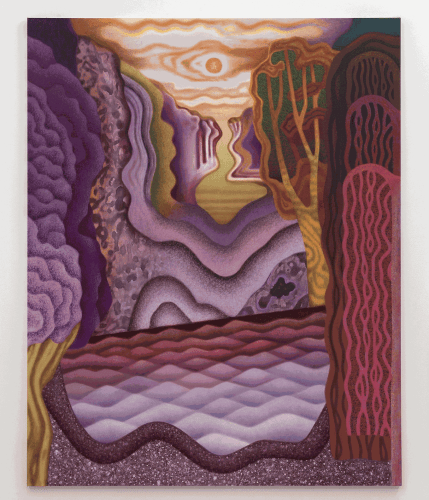A considerable shift occurred in Amanda Baldwin’s practice three years ago. Having risen to prominence working in still-life painting, the New York–based artist turned her attention to landscapes in 2020. “I noticed that many of my still-life or interior scenes had windows in the corner and, over time, I found myself more drawn to the realm beyond the window. I wanted to open it up and go outside,” Baldwin told Artsy in an interview.
Much like her still-life works, Baldwin’s landscapes take a subversive approach, destabilizing the conventions of a longstanding painting genre. Rather than rendering typical vignettes of pastoral beauty, Baldwin’s landscapes depict alluring alternative worlds created by distorting the architecture of reality. Featuring nine new pieces painted over the past year in her studio in Queens, “Wild Weeds,” Baldwin’s first solo exhibition with Public Gallery, affirms this relatively new direction for the artist.
Building on her recent solo presentations with Galerie Marguo in Paris and HESSE FLATOW in New York, the pieces on show at Public Gallery through December 15th are defined by hyperpigmented color palettes, multidimensional depth, and detailed patterning. In them, we see Baldwin delicately balancing seemingly opposing ideas to create worlds that are intrinsically beguiling but, crucially, still believable. In every piece, she thoughtfully incorporates elements of the real and the familiar, along with the imaginary and the unknown, to defy expectations while still portraying the beauty of the natural world.
“I like the idea of things being recognizable but at the same time different in my work,” she said. “There are very familiar elements that one is used to seeing in nature, but they are always a bit skewed, a bit different, or a bit exaggerated.” In Burning the Breeze (2023), for example, swirling pea-green patterns decorate a luminous yellow tree in an exaggeration of tree bark’s naturally occurring spiral grain. The mauve tree that lies behind it, meanwhile, sees Baldwin reimagining the natural fractals of tree branch distribution into an elegant haze of ombré paint.

